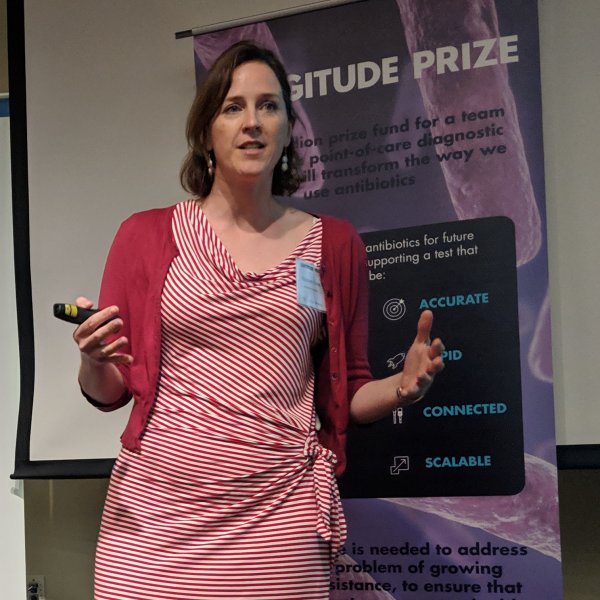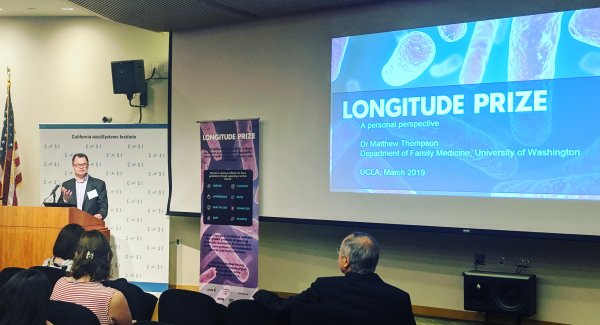Linking test developers to clinicians in the USA
01 May 2019
By Ruth Neale, Project Manager, Longitude Prize
Longitude Prize competitors are developing a range of innovative solutions to tackle antimicrobial resistance (AMR). As they come closer to the finish line, it’s imperative to ensure these tests will be useful in the clinic. Therefore we are connecting our test developers with front-line healthcare professionals, ensuring the tests being developed are as impactful as possible.
Two workshops were held: the first in Boston, in partnership with Combating Antibiotic Resistance Bacteria (CARB-X); and the second in Los Angeles in partnership with California NanoSystems Institute (CNSI) at University of California, Los Angeles (UCLA). At UCLA we also hosted a public event.
Twelve of our teams from the US and Canada plus other test developers based in the Northeast and Southern California attended the meetings. The events gave teams already registered with the Longitude Prize the opportunity to share experiences with companies considering registering and/or those working on a wide variety of tests to combat AMR.

Liz Cross, Nurse Practitioner from the UK presenting in LA.
Point-of-care diagnostic needs in UK clinics
The Longitude Prize is based in the UK and the winning team will be expected to market their test in the country. With these events we created an opportunity to explore specific needs in UK clinics and within the National Health Service (NHS).
Currently, there are limited point-of-care tests (POCT) available within NHS clinics designed to rule-out or -in antibiotic use. Liz Cross, a nurse practitioner in the Greater London Region, outlined the challenge for patients and the system when diagnoses based on clinical symptoms are inaccurate or inconclusive. Liz led a project to reduce antibiotic use in her clinic – 74% of antibiotic prescriptions in the UK take place in primary care.
With dedicated funding, Liz introduced CRP tests (viral vs bacterial differentiation) into her appointments when presented with patients with sore throats and colds. She successfully reduced antibiotic prescribing by 62% last winter.
“CRP tests are more objective for antibiotic prescribing and they help me take the emotions out of my appointments. I need a more sensitive and specific test, which is easy-to-use (especially with kids), connected and with clear instructions and a training package.”
– Liz Cross, nurse practitioner from the UK presenting in California.
But the main findings that stood out for her management team was that the CRP group had 32% less follow-up appointments. Reducing follow-up appointments not only saved resources but in a system where GP appointments are a scarce resource, they opened up appointments for other patients.
Diagnostic use in low-income health systems
Dr David Bell discussed lessons learnt from malaria diagnostic use in low and middle-income countries (LMICs) health systems, ideas on how to overcome challenges and how much of the malaria experience translates to AMR.
Hundreds of millions of dollars has been spent on malaria research, however malaria diagnostic technology has not progressed from Lateral Flow Assays, which were first introduced in 1993. The biggest problem is that malaria research and development is not being undertaken in the countries where we have malaria cases.
“Lack of understanding of the supply chain in LMICS is a key downfall in uptake of malaria diagnostic tests – but it is solvable! communication and integration are really important to understand the needs in LMICS.”
– Dr. David Bell, specialist in conception, development and introduction of new technologies in LMICS
Antibiotic resistance is a global problem that has arrived in US clinics
Antibiotic resistant E.coli is high across the US, but rates are even higher in California.
Dr David Haake, infectious disease specialist and professor of medicine at UCLA said, “A superbug outbreak at UCLA in 2015, cleared all the hospitals in LA – the public were avoiding hospitals after it was reported in the media. The superbug was caused by an organism carrying a previously unknown oxa-232 gene, which was not picked up or covered by the Cepheid oxa-48 diagnostic test being used in US clinics at the time. After the outbreak oxa-232 was added to the test however we still have unmet needs for diagnostics in primary care. Our ideal diagnostic needs high sensitivity, ability to identify species (especially Nitrofurantoin and fosfomycin for E. coli) and Antibiotic Susceptibility Testing (AST), to provide narrow spectrum antibiotics and avoid ineffective response.”
Antibiotic prescribing is relatively high in the US. The most commonly prescribed antibiotic is azithromycin and the specialty prescribing the most antibiotics is family practice. Participants at the meeting asked what is it going to take to have appropriate prescribing in the US? In the UK, one thing that worked was when the Chief Medical Officer singled-out and personally wrote to all high antibiotic prescribing clinicians about their antibiotic usage. Their rates dropped after receiving this communication.

Professor Matthew Thompson, Director at the University of Washington Primary Care Innovation Lab and Longitude Judge
Longitude Prize Judge Perspective
With the Longitude Prize deadline (end of 2020) fast approaching, to help our North American teams progress and successfully meet the eight Prize Rules criteria, Longitude Prize Advisory Panel (PAP) members joined our events to give their perspective and advice on what has been lacking in applications so far.
They posed the following questions:
- sample quality – are you measuring the right thing? Are the samples being collected at the right stage?
- adoption of new technologies – have you thought about different settings and lack of infrastructure (no electricity, fridges, water, trained staff). A test will not win the Prize that is designed only for a modern hospital in London or Boston. We need a test that works with little infrastructure so that it is practical to use in low-and middle-Income countries (LMICs).
- is the test affordable? One of the hardest criteria to explain, as it means different things to different people in different settings. The main question to ask is will your intended user buy it? We do not want a test to win and then sit on the shelf and not be used.
- lack of evidence – applications often have inadequate data. Do not leave the judges guessing and filling in gaps. Be explicit – how did you get from step A to step B.
“The limiting factor for antibiotic resistance is not science, there are great projects out there – I’ve seen it through Carb-x and the Longitude Prize. the barriers are economic, political, policy and social.”
